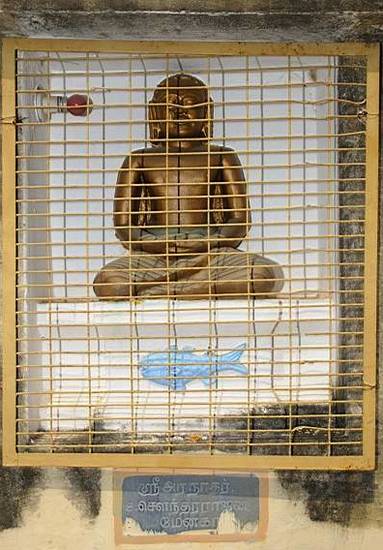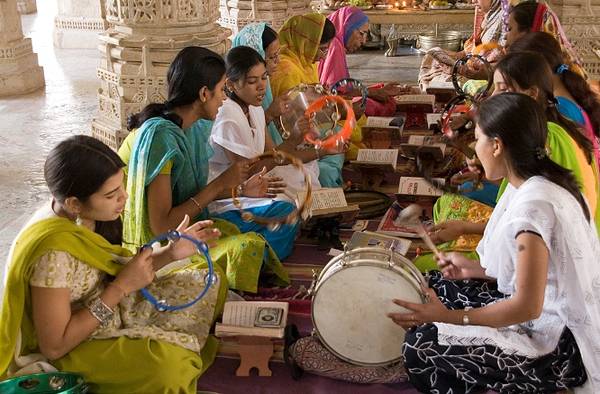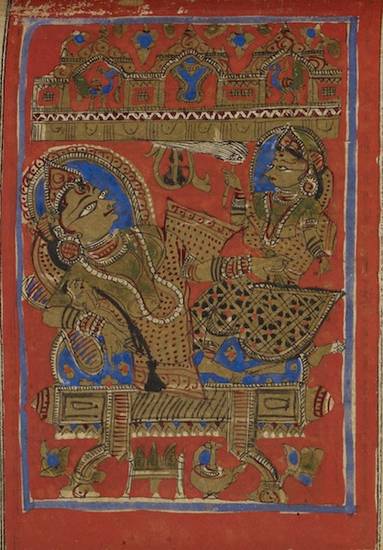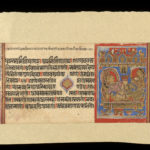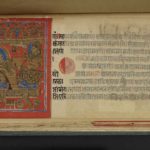Article: Three Jina festivals
Dates connected with events in the lives of all Jinas are all potential dates for festivals. Although they are all holy for the Jains, only some of them are the focus of public celebrations – Mahāvīr Jayantī and Dīvālī are the most prominent of these. The holy days of Maunaikādaśī, Poṣa-daśamī and Meru-trayodaśī do not have the same wide impact, but they display some of the same characteristics.
The features that are typical of most Jain festivals can be found in these three smaller festivals, including the close association of certain numbers with a holy day. As with all Jain festivals, the dates on which these smaller religious events take place vary year by year, because they are calculated in the lunar calendar. There are standard festival routines involving attending the local temple or mendicant dwelling-hall to listen to sermons and stories about the relevant Jina, particularly on the events in the Jina’s life that have inspired the festival. Performing hymns of praise to the Jina is a common activity, along with carrying out rituals. Devotees also take part in the common festival activities of fasting, donating money to the temple and taking the opportunity to reflect on the example of the Jina. They may also go on pilgrimages, timed to end when the festival begins. The side effects of festivals’ promoting fellow feeling among the Jain community and presenting a coherent identity to non-Jains are also found.
In addition, the Meru-trayodaśī festival is interesting because it shows the continuing development of religious practice. The major holy days have been such for centuries but the emergence of newer festivals such as Meru-trayodaśī illustrates the elastic qualities of the Jain religious calendar.
Maunaikādaśī
Usually falling around early December, Maunaikādaśī takes part of its name from the Sanskrit term for the date in the month it starts. Meaning ‘Silence Eleventh’, Maunaikādaśī takes the other part of its name from the vow of silence that some Jains take for this day.
It is closely associated with the five auspicious events that characterise the lives of all Jinas and above all with three Jinas:
Numbers are full of meaning in Jain philosophy and particularly so in this festival.
On this day, the Jain faithful will generally follow the customs shared by all the festivals in the religious calendar, including performing austerities such as fasts, listening to sermons and stories, and singing hymns. Reflection and meditation are also encouraged in Jain festivals.
Date and origin
Maunaikādaśī is the Sanskrit form of what is known in Gujarati as ‘Maun Agyāras’ or ‘Silence Eleventh’. It refers to the 11th day of the bright half of Mārgaśīrṣa, which is called Māgsar in Gujarati and is roughly from November to December in the Western calendar.
Maunaikādaśī is one of the richest days of the Jain religious calendar because some of the five auspicious events – kalyāṇakas – in the lives of three different Jinas took place on this date.
|
Auspicious event |
Jina |
Number of Jina |
|---|---|---|
|
Initiation as a monk – dīkṣā |
Ara |
18 |
|
Birth, initiation and omniscience |
19 |
|
|
21 |
This day has further numerical significance, being associated with the number 150. Numerology and mathematics are important aspects of Jain religious thought.
As well as the 24 Jinas in the Two and A Half Continents of Jain cosmology who live in the present era, there are other Jinas. They live in other continents in eras other than the current descending cycle of time. Counting the five auspicious events in the lives of all the Jinas, the total of auspicious events taking place on this date adds up to 150.
This total comes from the following calculation:
|
5 auspicious events |
x |
5 lands of Bharata |
25 |
|
5 auspicious events |
x |
5 lands of Airāvata |
25 |
|
Total auspicious events in all lands |
50 |
||
|
50 events |
x |
3 times (past + present + future) |
|
|
Total auspicious events in all lands and all times |
150 |
This is the reason traditional teachers such as Ratnaśekhara-sūri and Bhuvanavijaya give Maunaikādaśī a special place, regarding it as a kind of essence of all festivals. They say that the 22nd Jina Neminātha or Lord Nemi responded thus when his cousin Kṛṣṇa asked which festival was the most important.
Main activities

Breaking a fast
Image by Chandu Shah © Chandu Shah
The festival of Maunaikādaśī shares several key elements with the other Jain holy days. Many lay people take vows relating to temporary restraints on food. Attending sermons at the local temple or gathering-hall strengthens community bonds as well as passing on religious ideas. Hearing retellings of the events and individuals that have inspired the festival and singing hymns are also customary activities. However, the defining feature of this holy day, which gives it its name, is taking a vow of silence – mauna. This vow is mostly taken by monks and nuns (Cort 2001: 179).
The general atmosphere of Maunaikādaśī is one of serenity and self-restraint. As in other Jain festivals, the notions of self-control and dietary restrictions are prominent. Lay Jains often choose to keep vows relating to food during Maunaikādaśī. Vows regarding food restraints take three possible forms:
- dietary restrictions
- partial fasting
- complete fasting.
The first one is the lowest type of restraint and consists of not eating certain kinds of food for the period of the festival. The second kind is the average level and relates to the quantity of food. It usually means taking one meal a day instead of two or three. The final kind is at the extreme end of religious austerity. Only boiled water passes the lips of the devotees, who fast completely for a limited period of time. The water they drink must be boiled because only then can they be sure there is no life in it. It is therefore the only acceptable liquid from the religious point of view, since otherwise they may unknowingly commit violence.
As with all Jain festivals, on Maunaikādaśī lay Jains listen to sermons given by mendicants. The monks and nuns also give accounts of the Jinas and five auspicious events that have inspired the festival.
Devotees sing hymns of praise to the three Jinas celebrated in this festival:
- Aranātha or Lord Ara, the 18th Jina
- Mallinātha or Lord Malli, the 19th Jina
- Naminātha or Lord Nami, the 21st Jina.
There are many devotional songs that have been composed for this occasion by several authors.
Poṣa-daśamī
One of the most widely worshipped Jinas is the 23rd, Pārśvanātha or Lord Pārśva. Falling in late December or early January in the Western calendar, the festival of Poṣa-daśamī celebrates his birth and is thus also known as Pārśvanātha-jayantī.
The standard festival activities of fasting, worship, sermons and meditation feature in celebrations of Poṣa-daśamī. Special decorations are used to honour idols of the Jina and a lamp with 108 wicks is reserved for performance of the lamp ceremony. However, these are not required to mark the festival. Jains belonging to all sects observe Poṣa-daśamī and it is not strongly connected with any particular place, though some Gujarati Śvetāmbaras may go on a pilgrimage.
Date and origin
Poṣa-daśamī or ‘Poṣa Tenth’ is the day that commemorates the birth of Pārśvanātha or Lord Pārśva. The name of this celebration comes from its traditional date, represented, for instance, by the account in the Kalpa-sūtra or in Hemacandra’s Triṣaṣṭi-śalākā-puruṣa-caritra. In the latter’s words:
On the tenth of the dark half of [the month of] Pauṣa, [the moon] in rādhā [Vaiśākhā], she bore a son, dark blue in color, marked with a serpent, like the ground at the foot of a mountain bearing a jewel
Johnson’s translation, volume V, page 380, 1962
This date is valid for the areas which follow the north Indian calendar, which ‘begins with the dark half of the month and ends with the full moon’ (Cort 2001: 179). But in Gujarat, which conforms to the south Indian calendar, the month starts in the bright half of the month and ends with the new moon. Thus according to the calculation of the Gujarati calendar, Pārśva‘s birth is the tenth day of the dark half of the month of Mārgaśīrṣa, or Māgsar in Gujarati.
Main activities
Poṣa-daśamī does not demonstrate any very unusual celebrations. In common with other Jain festivals, Poṣa-daśamī is characterised by both communal and individual actions. This religious event therefore helps to generate community feeling among the local Jains and create a coherent Jain cultural and religious identity for outsiders. Devout lay people may individually choose to keep vows for the duration of the festival, usually relating to food. Activities involving the whole community of local Jains take place chiefly in the neighbourhood temple or mendicant dwelling-hall. Lay Jains visit the temple to hear the monks and nuns deliver sermons and stories relating to the subject of worship, Pārśvanatha or Lord Pārśva.
The Jina Pārśva is at the centre of worship during Poṣa-daśamī – his temples, his images and legendary episodes of his career. Statues of the Jina are hung with special ornaments and a dedicated lamp with 108 wicks may be used for the lamp ritual performed during regular evening worship. Although this festival can be celebrated anywhere, places with temples dedicated to Pārśva are especially popular.
For Gujaratis who want to practise a three-day fast – aṭṭham – Śankheśvar is a favourite destination. This is a favoured pilgrimage site in which to observe a three-day fast because it recalls a legendary episode. It is said that Kṛṣṇa, the cousin of the 22nd Jina Nemi, performed this fast there. This led him to obtain the Śankheśvar image of Pārśva, which was instrumental in his defeat of his enemy Jarāsandha (Cort 2001: 180).
Meru-trayodaśī

Ṛṣabha meditating
Image by Given by Miss Clara Montalba © Victoria and Albert Museum, London
The festival of Meru-trayodaśī does not always appear in lists of Jain holy days and has hardly been described in scholarly literature. An example of the overlap between a vow or religious commitment over a long period of time and a festival, it shows the flexibility of the Jain religious calendar in allowing certain holy days to evolve over time. The stories of the 24 Jinas offer numerous chances to commemorate significant events in their lives but not all such remembrances are celebrated widely enough to be considered festivals.
Meru-trayodaśī has developed from a day that marks a key event in the life of the first Jina, Ṛṣabhanātha or Lord Ṛṣabha, to a fairly well-known, if minor, festival. Centring on a vow to perform certain rituals each month, this festival can thus be seen as a way of completing the Jain religious calendar. Adding a date connected with Ṛṣabha, who is otherwise prominent only in the festival of Akṣaya-tṛtīyā, ensures that the most-worshipped Jinas each have festivals associated with them.
Date and origin
Meru-trayodaśī takes place annually on the 13th day of the dark half of Pauṣa, corresponding to mid-December to mid-January. Many Jain festivals commemorate an event relating to one of the 24 Jinas and Meru-trayodaśī is no exception, celebrating the liberation of the first Jina, Ṛṣabhanātha or Lord Ṛṣabha, which took place on mythical Mount Aṣṭāpada.
As in the case of the Pauṣa-daśamī festival, there is some variation in the date due to different calendrical systems. In the standard Śvetāmbara account of Ṛṣabha‘s life found in Hemacandra’s epic Triṣaṣṭi-śalākā-puruṣa-caritra, the date of Meru-trayodaśī is given as the 13th day of the dark half of the month of Māgha. This is roughly equivalent to mid-January to mid-March.
Numbers holding a special significance among Jains and frequently associated with festivals, Meru-trayodaśī is linked with 13, its date.
Main activities
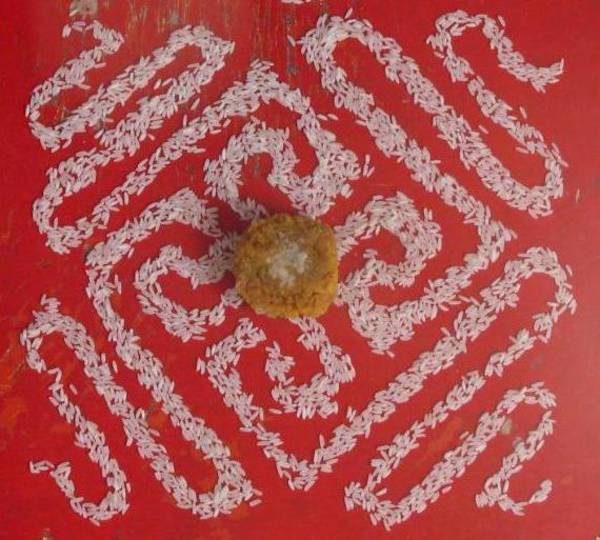
Nandyāvarta in rice
Image by Cactusbones – Sue Ann Harkey © CC Attribution-NonCommercial-ShareAlike 2.0
The Meru-trayodaśī rituals demonstrate particular elements of Jain religious philosophy, namely the auspiciousness of numbers, mantras, symbols and cosmographical features. The connection of the number 13 with the festival is underlined in some of the ceremonies.
According to a contemporary Śvetāmbara mendicant, Muni Bhuvana-vijaya, the festival consists of a sequence of rituals. These rites take place in addition to the standard activities associated with Jain festivals, such as going to the temple to hear sermons and stories, singing hymns, performing confession and making donations. Regularly performing the rites over given lengths of time is believed to destroy all the karmas that have been accumulated and to achieve success in this lifetime.
On the 13th day of the dark half of Māgha, the devotee observes a cauvihār fast. This fast means avoiding both food and water.
The devotee places five silver replicas of Mount Meru in front of an image of Ṛṣabhanātha or Lord Ṛṣabha. Four small replicas are set at each of the cardinal directions, with a bigger model in the centre.
The worshipper creates an auspicious svastika and nandyāvarta in front of each of the four small Merus. Then he or she performs pūjā with lights, incense and so on to each of the models.
The believer then recites the mantra Oṃ Hrīṃ Śrī Ṛṣabha-deva-pāraṃgatāya namaḥ – Homage to Ṛṣabha-deva who has reached the other shore – two thousand times. The term ‘the other shore’ refers to the emancipation of Ṛṣabha’s soul from the cycle of rebirth.
If the worshipper has been keeping a fast, he or she breaks it after offering alms to a monk or nun.
Performing these rituals is central to celebrating the holy day of Meru-trayodaśī. However, ideally, they should be repeated on the 13th day of the dark half of every month, for a minimum of 13 months and a maximum of 13 years. Completing this commitment ensures the destruction of karmas and worldly success in the current birth.
A devotee should observe the Meru-trayodaśī rituals according to his or her capabilities. This may mean that sometimes the festival is not celebrated, some months the fast cannot be completed or models of Mount Meru cannot be found.
Reading
- Śrī parvakathādi vividha viṣaya saṃgraha
Muni Bhuvanavijaya - Bhinmal, Rajasthan, India; 1980
- ‘Remembrance and Celebration: The Jain Religious Year’
John E. Cort - Jains in the World: Religious Values and Ideology in India
edited by John E. Cort
Oxford University Press USA; New York, New York, USA; 2001
- The Jains
Paul Dundas - Library of Religious Beliefs and Practices series; series editor John Hinnels and Ninian Smart; volume 14
Routledge Curzon Press; London, UK; 2002
- 'The Kalpa Sûtra of Bhadrabâhu'
Bhadrabāhu - translated and edited by Hermann Jacobi
Abhandlungen für die Kunde des Morgenlandes
Deutschen Morgenländischen Gesellschaft series; series editor Otto Loth; volume VII: 1
F. A. Brockhaus; Leipzig, Saxony, Germany; 1879
- ‘Festivals’
Jyoti Prasad Jain - Religion and Culture of the Jains
Jñānapīṭha Mūrtidevī granthamālā: English series; volume 6
Bhāratīya Jñānapītha; New Delhi, India; 1975
- Śrāddhavidhiprakaraṇa
Ratnaśekhara-sūri - Śreṣṭhi-Devacanda-Lālbhāī-Jaina Pustakoddhara Fund series; volume 106
Surat, Gujarat, India; 1960
- Historical Dictionary of Jainism
Kristi L. Wiley - Historical Dictionaries of Religions, Philosophies, and Movements series; series editor Jon Woronoff; volume 53
Scarecrow Press; Maryland, USA; 2004
Links
- Poṣa-daśamī in 2009
-
This YouTube video shows the 2009 festival of Poṣa-daśamī in Jaipur, Rajasthan. Celebrating the birth of the 23rd Jina Pārśvanātha or Lord Pārśva, the festival is observed by all Jain sects. An idol of the Jina is carried through the streets in a silver crib inside a larger shrine, surrounded by a procession of lay people. The local community makes offerings to the Jina when the procession reaches the temple.
- Poṣa-daśamī – part 1
-
The Poṣa-daśamī festival celebrates the birth of the 23rd Jina, Pārśvanātha or Lord Pārśva. Held in late December or early January in the Western calendar, Poṣa-daśamī is also known as Pārśvanātha-jayantī. Typically of many Jain festivals, an idol from a local temple is the centre of a procession through the streets – ratha-yātrā. The procession includes decorated animals, musicians, lay Jains and white-clad nuns. The Jina image is hung with bright flower garlands and is fanned with fly-whisks, symbolic of royalty. Lay Jains dance, sing and clap as the statue is brought into the temple at the end of the procession.
This two-part YouTube video records the 2010 Poṣa-daśamī festival in Jaipur, Rajasthan as celebrated by Śvetāmbara Jains. This is the first part .
http://www.youtube.com/watch?v=YihWayx7NKQ
Watch the second part here https://www.youtube.com/watch?v=UddsDpAwYAY
- Poṣa-daśamī – part 2
-
Commemorating the birth of the 23rd Jina, Pārśvanātha or Lord Pārśva, the Poṣa-daśamī festival is also known as Pārśvanātha-jayantī. It is celebrated in late December or early January in the Western calendar. Following a street procession – ratha-yātrā – the garlanded statue of Pārśva is brought into the local temple, while a conch is blown and a bell rung. The local community gathers around it and sings hymns in celebration. Chanting, they move a tray of fire in circles, offering pūja or worship to the statue. All the other images of Jinas in the temple are also decorated with flowers.
This two-part YouTube video records the 2010 Poṣa-daśamī festival in Jaipur, Rajasthan as celebrated by Śvetāmbara Jains. This is the last part.
http://www.youtube.com/watch?v=vXsnBlBDOHk
https://www.youtube.com/watch?v=UddsDpAwYAY
- Hymn to Mallinatha
-
This 2007 YouTube video features a Digambara monk singing a hymn – stotra – honouring the 19th Jina, Mallinātha or Lord Malli. The visuals show a Śvetāmbara idol of the Jina over a pulsing, colourful background.
- Mallinatha temple
-
This YouTube video from IndiaVideoDotOrg shows the journey up to the temple dedicated to the 19th Jina Mallinātha or Lord Malli on Mount Girnar. Constructed in 1230, the triple temple is one of the first shrines pilgrims encounter on the mountain. A holy place for Jains and Hindus in Gujarat, Girnar is a popular pilgrimage destination for followers of both religions.
- Statue of Malli
-
This picture on Flickr is of a Digambara statue of Malli, the 19th Jina, seated on a lotus-flower pedestal. The statue's long earlobes signify the renunciation of wealth and worldly status. Depicted in the lotus pose of meditation with closed eyes, the sculpture exhibits the typical unadorned style of Digambara Jinas.
- Idol of Mallī
-
A Śvetāmbara statue of the 19th Jina is provided on Flickr. The black colour of the image makes the wide open eyes and tilaka – symbolising the third eye – very noticeable. According to Śvetāmbara Jains, Mallinātha or Lord Mallī is the only Jina who is female. Artistic depictions of Mallī as a woman are rare or inconclusive, however, as most representations of Jinas are highly stylised and undifferentiated from one another.
- +
- aAbhavya
- aAbhinandana
- aAbhiṣeka
- aĀcāra
- aĀcārāṅga-sūtra
- aĀcārya
- aAchalbhrata
- aAḍhāī-dvīpa
- aAdharma
- aAdho-loka
- aAdhyayana
- aAdvaita Vedānta
- aĀgama
- aAghātīya
- aAghātīya-karman
- aAgnibhuti
- aAgra
- aĀhāra
- aAhiṃsā
- aAhimsa Day
- aAjita
- aAjīva
- aAkampit
- aĀkāśa
- aAkbar the Great
- aAkṣaya-tṛtīyā
- aAlauddin Khalji
- aAlbert Einstein
- aAllah
- aAlms
- aĀlocanā
- aAloka-ākāśa
- aAmāri
- aAmbikā or Kūṣmāṇḍinī
- aAnagāra
- aAnanta
- aAnarthadaṇḍa
- aAnaśana
- aAnekānta-vāda
- aAṅga
- aAniconism
- aAnojjā
- aAntarāla
- aAntarāya-karma
- aAṇu
- aAṇu-vrata
- aAnukampā
- aAnuprekṣā
- aAnusvāra
- aApabhraṃśa
- aAparigraha
- aAra
- aĀrambha
- aĀrambhaja
- aĀratī
- aArdhamāgadhī Prākrit
- aArhaṃ
- aArhat
- aArśana-āvaraṇīya-karma
- aĀrta-dhyāna
- aĀryikā
- aĀryikā Jñānamati
- aĀśātanā
- aĀścarya
- aAscetic
- aAsceticism
- aAshram
- aAspiration
- aĀsrava
- aAṣṭa-maṅgala
- aAṣṭāpada
- aAstikāya
- aAstrolabe
- aAsura
- aAtheism
- aAticāra
- aAtiśayakṣetra
- aAtithisaṃvibhāgavrata
- aĀtma-vāda
- aĀtman
- aAuṃ
- aAurangzeb
- aAuspicious
- aAusterity
- aAvadhāna
- aAvadhi-jñāna
- aĀvaraṇī-yakarman
- aAvasarpiṇī
- aAvatāra
- aAvidyā
- aAxiom
- aĀyāga-paṭa
- aĀyambil
- aĀyu-karma
- aĀyurveda
- bBabur
- bBāhubali
- bBaladeva
- bBālāvabodha
- bBandha
- bBasadi
- bBazaar
- bBhadrankarvijay
- bBhagavant
- bBhaktāmara-stotra
- bBhakti
- bBhale
- bBharata
- bBhāṣā
- bBhāṣya
- bBhaṭṭāraka
- bBhāva
- bBhāva-pūjā
- bBhāvanā
- bBhavana-vāsin
- bBhavya
- bBhavyatva
- bBhaya
- bBhoga-bhūmi
- bBhogopabhoga
- bBodhi
- bBollywood
- bBrahmā
- bBrahma-deva
- bBrahmacārī
- bBrāhmaṇa
- bBraj Bhāṣā
- bBright fortnight
- bBritish Raj
- bBuddha
- bBuddhi-sagar
- bBuddhism
- bBuddhist
- cCaitya
- cCaityavāsin
- cCakravartin
- cCakreśvarī
- cCāmara
- cCandanā
- cCandragupta
- cCandraprabha
- cCanon
- cCāritra
- cCāritramohanīya-karman
- cCarũrī
- cCaste
- cCaturvidha-saṅgha
- cCaturviṃśati-stava
- cCāturyāma
- cCE
- cCelibacy
- cCha
- cChadmastha
- cChastity
- cCheda-sūtra
- cChristian
- cChristianity
- cClergy
- cCloning
- cColophon
- cCommentary
- cConch
- cConfession
- cCongregation
- cConsecration
- cCosmology
- cCremation
- cCrore
- cCult
- cCūrṇi
- dDādā-guru
- dDalit
- dDāna
- dDaṇḍa
- dDark fortnight
- dDarśana
- dDarśanamohanī-yakarman
- dDaśa-lakṣaṇa-parvan
- dDeity
- dDelhi Sultanate
- dDerāsar
- dDeśāvakāśika-vrata
- dDetachment
- dDevanāgarī
- dDevānandā
- dDevarddhi-gani
- dDevotee
- dDhamal
- dDhanuṣ
- dDhāra
- dDharma
- dDharma-dhyāna
- dDharma-sāgara
- dDharmastikaya
- dDhātakīkhaṇḍa
- dDholak
- dDhyāna
- dDiaspora
- dDig-vrata
- dDigambara
- dDīkṣā
- dDisciple
- dDīvālī
- dDivya-dhvani
- dDNA
- dDoctrine
- dDogma
- dDonor
- dDoṣa
- dDravya
- dDravya-pūjā
- dDrone
- dDuṣamā
- dDuṣamā-duṣamā
- dDuṣamā-suṣamā
- dDveṣa
- dDvīpa
- eEast India Company
- eEightfold Path
- eEkānta-vāda
- eEkendriya
- eElder
- eElders
- eEschatology
- eEtc up to
- fFarmān
- fFast
- fFatehpur Sikri
- fFestival
- fFestschrift
- fFiruz Shah
- fFly-Whisks
- fFolio
- fFour Noble Truths
- gGaccha
- gGaṇa
- gGaṇadhara
- gGanadharavada
- gGaṇeśa
- gGaṇin
- gGarba
- gGarbha
- gGarbha-gṛha
- gGaruḍa
- gGati
- gGene
- gGenomics
- gGhātī-yakarman
- gGhātīya
- gGhaznavid
- gGhiyasuddin Tughlaq
- gGhurid
- gGloss
- gGotra-karma
- gGujarāt
- gGujarati
- gGuṇa
- gGuṇa-sthāna
- gGuṇa-vrata
- gGupti
- gGuru
- gGuruṇī
- hHagiography
- hHajj
- hHaṃsa
- hHaribhadra
- hHariṇaigameṣin
- hHasta
- hHeresy
- hHiṃsā
- hHindi
- hHindu
- hHinduism
- hHīravijaya
- hHoroscope
- hHrīṃ
- hHumayun
- hHymn
- iIconoclasm
- iIconography
- iIdol
- iIndian Independence
- iIndology
- iIndra
- iIndrabhūti Gautama
- iIndriya
- iInitiation
- iIntercession
- iInvocation
- iIQ
- iIslam
- iIslamicate
- iIṣṭadevatā
- iĪśvara
- jJagat
- jJahangir
- jJain
- jJaina Devanāgarī
- jJaina Śaurasenī
- jJaina-dharma
- jJainaśāsana
- jJainness
- jJaisalmer
- jJamāli
- jJambū-dvīpa
- jJames Burgess
- jJanma
- jJanma-kalyāṇa
- jJarā
- jJāti
- jJina
- jJina-āgama
- jJina-bhavana
- jJina-bimba
- jJina-mātā
- jJinacandra-sūri
- jJinadatta
- jJinaprabha
- jJīva
- jJñāna
- jJñāna-āvaraṇīya-karma
- jJñāna-āvarṇiya
- jJñānsundar
- jJyotiṣka
- kKāla
- kKālakācārya-kathā
- kKālidāsa
- kKalpa-sūtra
- kKalpa-vṛkṣa
- kKalyāṇaka
- kKalyanvijay
- kKamaṇḍalu
- kKamaṭha
- kKarma
- kKarma-bhūmi
- kKarma-grantha
- kKarma-prakṛti
- kKarma-vāda
- kKarmon
- kKarnataka
- kKaṣāya
- kKathā
- kKāvya
- kKāya
- kKāyotsarga
- kKeśa-loca
- kKetu
- kKevala-jñāna
- kKevalin
- kKhalji
- kKharatara-gaccha
- kKnowledge
- kKriyā
- kKriyā-vāda
- kKṛṣṇa
- kKṣamā-śramaṇa
- kKṣapakaśreṇi
- kKṣatriya
- kKṣullaka
- kKulakara
- kKundakunda
- kKunthu
- lLabdhi
- lLaity
- lLakh
- lLāñchana
- lLands of Action
- lLaukāntika
- lLavaṇa-samudra
- lLeśyā
- lLiṅga
- lLinguistics
- lLoka
- lLoka-ākāśa
- lLoka-puruṣa
- lLoka-vāda
- lLotus
- lLotus lake
- mMadhya-loka
- mMahā-videha
- mMahā-vrata
- mMahābhārata
- mMahāmastakābhiṣeka
- mMāhārāṣṭra
- mMāhārāṣṭrī Prākrit
- mMahattarā Yākinī
- mMahāvīr Jayantī
- mMahāvīra
- mMakāra
- mMakkhali Gośāla
- mMalli
- mMāna-stambha
- mManaḥ-paryāya-jñāna
- mMaṇḍala
- mMaṇḍapa
- mMandit
- mMaṅgala
- mMantra
- mMantras
- mManuṣya-loka
- mMarāṭhī
- mMārgaṇā
- mMartyr
- mMarudevī
- mMaṭha
- mMati-jñāna
- mMauryaputra
- mMecca
- mMendicant lineage
- mMetarya
- mMiracle
- mMithyādṛṣṭi
- mMohandas Gandhi
- mMohanīya-karma
- mMokṣa
- mMonastic order
- mMonasticism
- mMonk
- mMonotheism
- mMosque
- mMount Meru
- mMount Sammeta
- mMṛgāvatī
- mMughal
- mMuhammad
- mMuhammad bin Tughlaq
- mMuhpattī
- mMūla-sūtra
- mMūlaguṇa
- mMumbaī
- mMuni
- mMunisuvrata
- mMurad Bakhsh
- mMūrti-pūjaka
- mMuslim
- mMysticism
- nNābhi
- nNāga-kal
- nNāgapurīya Tapā-gaccha
- nNāgarī
- nNāma-karma
- nNamaskāra-mantra
- nNami
- nNandīśvara-dvīpa
- nNandivardhana
- nNandyāvarta
- nNāraka
- nNāraki
- nNasalisation
- nNātha
- nNavrātrī
- nNaya-vāda
- nNemi
- nNidāna
- nniggaṃthāṇa vā 2
- nniggaṃtho vā 2
- nNigoda
- nNihnava
- nNikṣepa
- nNirgrantha
- nNirjarā
- nNirvāṇa
- nNiryukti
- nNiṣidhi
- nNitya
- nNiyati
- nNo-kaṣāya
- nNudity
- nNun
- oOcean of milk
- oOmniscience
- oOrdination
- ppa°
- pPadmaprabha
- pPadmāsana
- pPadmāvatī
- pPādukā
- pPalanquin
- pPalette
- pPañca-muṣṭi
- pPāṇḍava
- pPaṇḍit
- pPandit Dalsukh D. Malvania
- pPandit Sukhlalji
- pPāṇipātra
- pPāpa
- pParamātman
- pParameṣṭhin
- pPāraṇā
- pParigraha
- pPariṇāma
- pParīṣaha
- pParokṣa
- pPārśva
- pPārśvanātha
- pParyāya
- pParyuṣaṇ
- pPaṭa
- pPatan
- pPātra
- pPenance
- pPersian
- pPhala
- pPhilology
- pPicchikā
- pPilgrimage
- pPīr
- pPolymath
- pPoṣadha
- pPossession
- pPothī
- pPrabhas
- pPradakṣiṇā
- pPradeśa
- pPrākāra
- pPrakīrṇaka-sūtra
- pPrākrit
- pPramāda
- pPramukhā
- pPrati-vāsudeva
- pPratikramaṇa
- pPratimā
- pPratiṣṭhā
- pPratyākhyāna
- pPratyakṣa
- pPravacana
- pPrāyaścitta
- pPrayer
- pPre-modern
- pPreach
- pPredestination
- pProtestant
- pProvenance
- pPudgala
- pPūjā
- pPujārī
- pPukharavara-dvīpa
- pPuṇya
- pPūrva
- pPuṣkara-dvīpa
- pPuṣpadanta
- pPyre
- qQur’an
- rRāga
- rRāhu
- rRainy season
- rRajasthan
- rRajasthani
- rRājimatī
- rRajoharaṇa
- rRajput
- rRāma
- rRāmāyaṇa
- rRangoli
- rRās-garbā
- rRasa
- rRathanemi
- rRatna-traya
- rRātri-bhojana
- rRaudra-dhyāna
- rRecto
- rRelic
- rRenunciation
- rRetroflex
- rRevatī
- %Ṛg-veda
- rRite
- rRosary
- %Ṛṣabha
- %Ṛṣabhanātha
- rRupee
- sSaciyā Mātā
- sSādhu
- sSādhvī
- sSāgāra
- sSaint
- sŚaivaism
- sŚaka-saṃvat
- sSallekhanā
- sŚalya
- sSamacatuṣṭha
- sSamādhimaraṇa
- sSamaṇi
- sSāmarambha
- sSamavasaraṇa
- sSāmāyika
- sSaṃbhava
- sSamiti
- sSaṃjñā
- sSaṃkalpaja
- sSaṃsāra
- sSamudghāta
- sSaṃvara
- sSaṃvega
- sSamyak-cāritra
- sSamyak-darśana
- sSamyak-jñāna
- sSamyaktva
- sSaṃyama
- sSanctuary
- sSandalwood
- sSaṇgha
- sSanskrit
- sSant
- sŚānti
- sSapta-bhaṅgi-naya
- sSārambha
- sSarasvatī
- sSarvajña
- sSāsan-devi
- sŚāsana-devatā
- sŚāstra
- %Ṣaṭ-jīvanikāya
- sSatī
- sSatīmātā
- sSatya
- sSchism
- sScribe
- sScripture
- sSect
- sSecularism
- sŚenāī
- sSermon
- sŚeṣavatī
- sSevā
- sSeven fields of donation
- sShah Jahan
- sShantidas Jhaveri
- sShrine
- sSiddha
- sSiddha-śilā
- sSiddhacakra or Navadevatā
- sSiddhānta
- sSiddhārtha
- sSiddhi
- sSikh
- sSikhism
- sŚikṣā-vrata
- sŚīla
- sSin
- sSindh
- sŚītala
- sŚiva
- sSkandha
- sSomanatha
- sŚraddhā
- sŚramaṇa
- sŚrāvaka
- sŚrāvakācāra
- sŚrāvikā
- sŚreyāṃsa
- sŚrī
- sŚrīvatsa
- sŚruta-jñāna
- sŚruta-pañcamī
- sSthānaka-vāsin
- sSthāpanācārya
- sSthāvara
- sSthavira
- sSthiti
- sStrīmukti
- sStūpa
- sSubcontinent
- sSudarshana
- sŚuddhi
- sSudharma
- sŚūdra
- sSufism
- sSukha
- sŚukla-dhyāna
- sSulasā
- sSultan
- sSumati
- sSundarśrī
- sSupārśva
- sSūri
- sSuṣamā
- sSuṣamā-duṣamā
- sSuṣamā-suṣamā
- sSūtra
- sSuyam me ausam! Tenam bhagavaya evamakkhayam
- sSvādhyāya
- sSvāhā
- sSvastika
- sŚvetāmbara
- sŚvetāmbara Terāpanthin
- sŚvetāmbaras
- sSwan
- sSyād-vāda
- tTabla
- tTantra
- tTapā-gaccha
- tTapas
- tTāraṇ Svāmī Panth
- tTattva
- tTattvārtha-sūtra
- tTemple
- tTemple-city
- tThe Enlightenment
- tTheology
- tThree worlds
- %Ṭīkā
- tTilaka
- tTīrtha
- tTīrthaṃkaranāma-karman
- tTīrthankara
- tTransliteration
- tTrasa
- tTrasa-nāḍī
- tTriśalā
- tTriṣaṣṭi-śalākā-puruṣa-caritra
- tTti bemi
- tTughlaq
- tTunk
- uUdumbara
- uUniversal History
- uUpādhyāya
- uUpāṅga
- uUpaniṣads
- uUpāsaka
- uUpasarga
- uUpāśraya
- uŪrdhva-loka
- uUtsarpiṇī
- uUttarādhyayana-sūtra
- vVāhana
- vVaimānika
- vVairāgya
- vVaiṣṇava
- vVaiśramaṇa
- vVaiśya
- vValabhī
- vVanaspatikāya
- vVandana
- vVaṇik
- vVarṇa
- vVāsudeva
- vVāsupūjya
- vVayubhūti
- vVeda
- vVedanīya-karma
- vVegetarianism
- vVehicle
- vVernacular
- vVerso
- vVidyā
- vVidyā-devī
- vVihāra
- vVijñapti-patra
- vVikrama-saṃvat
- vVikṛti
- vVimala
- vVinaya
- vVipāka
- vVirji Vora
- vVirodhaja
- vVīrya
- vVisarga
- vViṣṇu
- vVītarāga
- vVizier
- vVotive
- vVow
- vVrata
- vVS
- vVyakta
- vVyantara
- vVyasana
- yYakṣa
- yYakṣī
- yYantra
- yYaśoda
- yYaśovijaya
- yYati
- yYātrā
- yYoga
- yYoginī
- yYojana


